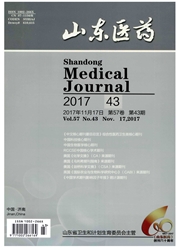

 中文摘要:
中文摘要:
目的探讨C-Jun氨基末端蛋白激酶(JNK)/应激激活蛋白激酶(SAPK)在慢性阻塞性肺疾病(COPD)大鼠肺组织中的水平变化及意义。方法 16只Ⅱ级Wistar雄性大鼠随机分为对照组和COPD组。对照组不予任何处理,COPD组给予烟熏刺激,造成大鼠COPD动物模型。造模成功后,光镜下观察肺组织病理,动物肺功能检测仪检测肺功能,ELISA法检测大鼠肺组织TNF-α水平,免疫组化法检测肺组织JNK/SAPK表达,RT-PCR检测肺组织JNK/SAPK mRNA表达水平。结果 COPD组光镜下出现了大量炎性细胞浸润,部分肺泡融合,肺泡数量减少,证明COPD造模成功。与对照组比较,COPD组第0.3秒用力呼气容积与用力呼气容积的比值降低,呼气阻力、吸气阻力升高,动态顺应性下降(P〈0.05或〈0.01),TNF-α升高(P〈0.05);免疫组化结果显示,COPD组肺组织中JNK/SAPK蛋白表达高于对照组(P均〈0.05)。RT-PCR结果显示,与对照组相比,COPD组JNK/SAPK mRNA水平升高(P均〈0.05)。JNK/SAPK mRNA表达水平与TNF-α呈正相关(r=0.751,P〈0.05)。结论烟雾诱导的COPD大鼠JNK/SAPK水平升高,其可能通过激活烟雾诱导的炎症因子,导致气道炎症和肺气肿,促进COPD发生。
 英文摘要:
英文摘要:
Objective To investigate the changes in levels of c-Jun N-terminal kinase/stress-activated protein kinase( JNK/SAPK) in the lung tissues of rats with chronic obstructive pulmonary disease( COPD). Methods Sixteen Ⅱ male Wistar rats were randomly divided into two groups: the control group and COPD group. The control group was not treated,while the COPD group was stimulated with smoke to set up COPD models. After models were established,we detected the lung pathology through optical microscope,pulmonary function through animal pulmonary instrument,TNF-α expression in lung tissue through ELISA,JNK/SAPK expression through immunohistochemistry,and JNK mRNA expression through RTPCR. Results In the COPD group,light microscope showed that there was a large number of inflammatory cell infiltration,alveolar fusion,and alveolar reduction,which proved the COPD model was successful. Compared with the control group,FEV0. 3/FVC decreased,Ri and Re increased,and Cldyn decreased( P〈0. 05 or P〈0. 01),and TNF-α increased in the COPD group( P〈0. 05). Immunohistochemistry showed that JNK/SAPK expression improved in the COPD group. RT-PCR result showed JNK mRNA expression increased in the COPD group as compared with that of the control group( all P〈0. 05). JNK mRNA expression was positively correlated with TNF-α( r = 0. 751,P〈0. 05). Conclusion The level of JNK/SAPK increases in smoke-stimulated COPD rats,which can cause airway inflammation and emphysema,and promote the occurrence of COPD through activating smoke-induced inflammatory cytokines.
 同期刊论文项目
同期刊论文项目
 同项目期刊论文
同项目期刊论文
 期刊信息
期刊信息
